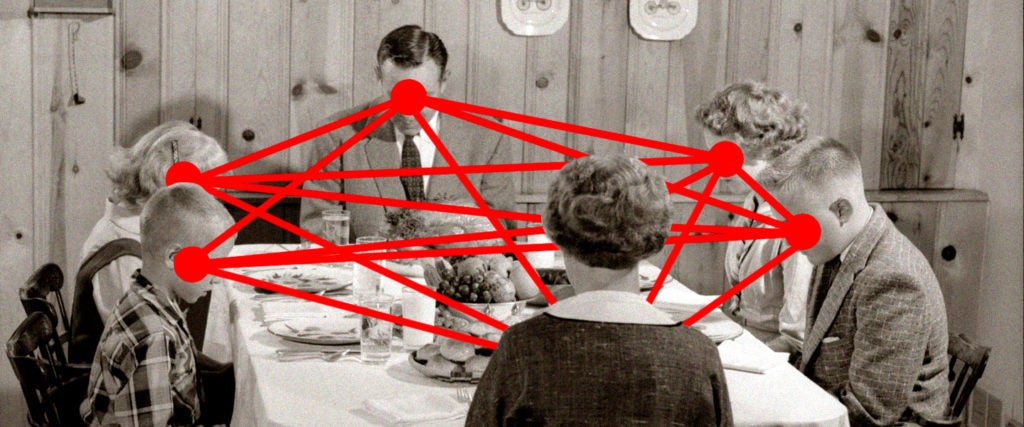The reality of this current moment in history is that Thanksgiving, the holiday institutionalizing the celebration of colonialism as a net-good for humanity, is going to result in a lot of death (again). A recent national survey by the Ohio State University Wexner Medical Center found that two out of every five people plan to attend a Thanksgiving get together with more than 10 people. This comes on the heels of what’s been the highest coronavirus infection rate since the pandemic began, not to mention the increasing number of hospitalizations nationwide. But you know what, I’m not here to scold the citizens of this death cult we call America — I’m tired of the scolding and clearly, as the numbers appear to indicate, you’ve stopped listening.
Furthermore, as we’ve learned these past several months, calling someone careless isn’t going to change their behavior. Emily Gurley, an epidemiologist at Johns Hopkins University who teaches an online course on contact tracing, tells me as much, suggesting that “some of that language can be divisive,” and therefore worthless. “All of us are at some risk,” she says. “Some people are at high risk because of things they choose to do. Some people are at high risk just because of the reality of their life. So it’s important to recognize we all have risks. And the question is, how are you going to allocate your risk?”
Your Thanksgiving get together not only hinges on your personal allocation of risk, but that of everyone else you decide to stuff your face with. “So, we need to take a bit of a more nuanced picture or perspective on our own individual risk,” says Gurley. Part of that nuanced perspective, she continues, is the basis for contact tracing. As summarized by an AP News report, “The goal of contact tracing is to alert people who may have been exposed to someone with the coronavirus, and prevent them from spreading it to others.” And if you’re planning on seeing family on Turkey Day, contact tracing is going to be key.
Though contact tracing is done in a variety of ways, a common issue, according to the same AP News piece, is that “determining who a person has been around can get harder as gatherings with friends and family resume, and as bars, restaurants and other places start reopening.” Complicating matters further is the fact that, as Audrey Snyder, associate dean for experiential learning at the University of North Carolina at Greensboro’s School of Nursing, told my colleague Lauren Vinopal earlier this year, “If people aren’t practicing good behaviors, they’re reluctant to be honest about who they’ve been in contact with.”
In its simplest form, Gurley says that the purpose of contact tracing is to find people who are infected and, thereby, the people who could be infected, the idea being to get the latter “to change their behavior so that they don’t infect anyone else while they could be infectious,” she says. “So the main point [of contact tracing] is that people change their behavior, and they isolate and quarantine themselves to stop those chains of transmission.”
All of which means, if you plan on contact tracing your own Thanksgiving, you’re going to have to trust that the information that’s provided to you is honest. To that end, my colleague Brian VanHooker effectively contact traced his mother-in-law before she came to his home by casually asking her, “What you been up to?” “Generally, that prompts a response that’s paragraphs long,” he tells me. “So it worked really well, actually.”
This, says Gurley, is an important point: To ensure as little risk as possible, most of the contact tracing needs to be done before your gathering. Which, she explains, includes putting together a list of the people your family members have been in contact with, then finding those contacts and asking them who they’ve been around and whether or not any of those people have been diagnosed with COVID. “And then follow-up over time,” in the days leading up to your get together, says Gurley. Thus, to truly contact trace your Thanksgiving effectively, you’re likely going to have to reach out to the friends, colleagues and even acquaintances of your family members and hope that they don’t lie to you, a probable stranger.
To put it another way: Contact tracing your own Thanksgiving get together is a fool’s errand.
The other thing Gurley says that you should broadly be aware of is that, although transmission is increasing everywhere in the U.S., there are some places where it’s much higher than others. “People should know locally what’s going on,” she says. “If you’re coming from an area with very high transmission, you should act accordingly, and you should assume that you’re also at high risk for being infected, unless you’re shuttered up in your house all the time,” she says.
But again, any traveling and getting together is a recipe for disaster. In truth, contact tracing isn’t a good way to put your mind at ease while you dine on some dry turkey legs, because it’s very difficult to fully trace people’s whereabouts, particularly people you hardly know. So do with that what you will. Hopefully, if nothing else, it helps you reconsider the number of people you include at your Thanksgiving table.

